Ever wondered can you freeze salmon? The answer is yes! Freezing salmon is one of the best ways to extend its shelf life while preserving its flavor and nutrients. With the right techniques, you can store fresh salmon for months and enjoy it whenever you want. Whether you’ve bought salmon in bulk or have leftovers from a recipe like Pineapple Sweet Chili Salmon, freezing is a practical way to avoid waste.
In this guide, you’ll learn how to freeze salmon properly, how long it lasts in the freezer, and tips for thawing it safely. Let’s dive into everything you need to know about freezing salmon.
Why Freeze Salmon?
Freezing salmon is not only convenient but also an excellent way to retain its quality over time. Here’s why it’s worth considering:
1. Preserve Freshness
Freezing locks in the flavor and nutrients of salmon, ensuring it stays as fresh as the day you bought it. Properly frozen salmon retains its vibrant color, firm texture, and rich taste for months.
2. Save Money
Buying salmon in bulk and freezing it is cost-effective. Whether it’s a great deal at the grocery store or a catch from your latest fishing trip, freezing lets you enjoy high-quality salmon without breaking the bank.
3. Reduce Food Waste
If you’ve made too much salmon or don’t plan to cook it soon, freezing prevents spoilage. Leftovers from recipes like Rotisserie Chicken Casserole Stuffing or Healthy Deviled Eggs Without Mayo can also be frozen for future use.
Freezing salmon is a simple solution for maintaining its quality and ensuring you always have this versatile fish on hand.
How to Freeze Salmon? Step-by-Step Instructions
Freezing salmon is easy, but doing it correctly ensures it stays fresh and flavorful for months. Follow these steps for the best results:
Step 1: Choose High-Quality Salmon
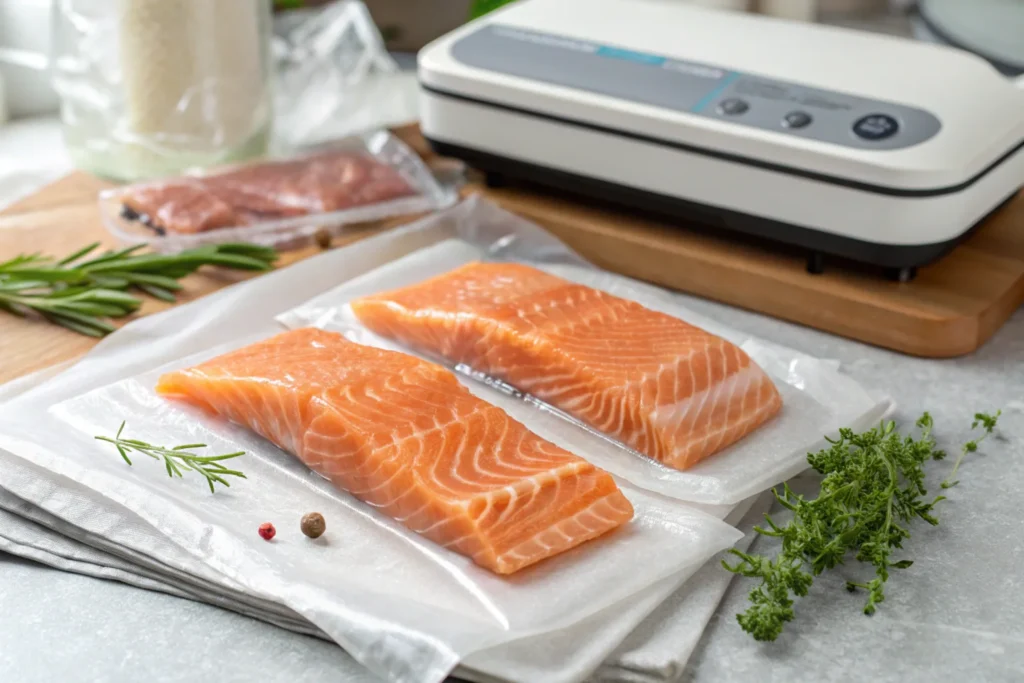
Always start with the freshest salmon available. Fresh salmon freezes better and retains its flavor and texture longer. Look for fillets with a bright, vibrant color and no strong fishy odor. Wild-caught salmon typically freezes better than farm-raised due to its firmer texture.
Step 2: Prep the Salmon for Freezing
Before freezing, clean and portion the salmon to make it easier to use later. Pat the fillets dry with a paper towel to remove excess moisture, which can lead to ice crystals. If you prefer, remove the skin and bones, although keeping the skin intact can help protect the flesh during freezing.
Step 3: Wrap the Salmon Properly
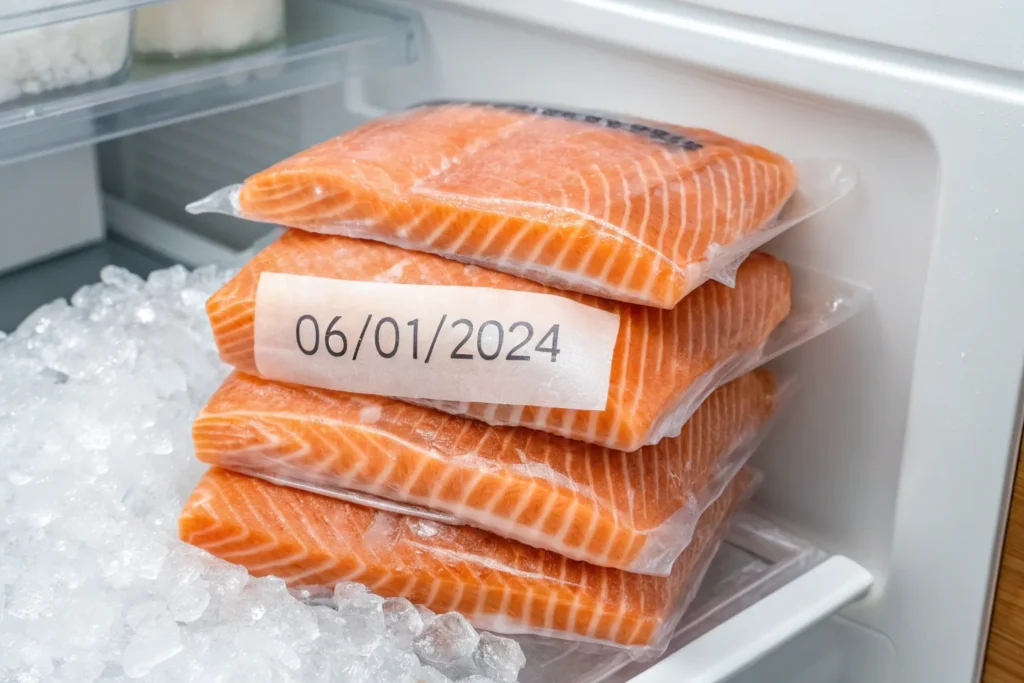
Tightly wrapping salmon is crucial to preventing freezer burn. Wrap each portion in plastic wrap, ensuring no air is trapped. Place the wrapped portions in a freezer bag and squeeze out as much air as possible. For the best results, use a vacuum sealer it creates an airtight seal that keeps the salmon fresh longer. Label the bags with the freezing date and portion sizes for easy identification.
Step 4: Freeze Quickly
Set your freezer to its coldest setting before freezing salmon. Lay the portions flat in a single layer to freeze them evenly and save space. Once the salmon is frozen solid, you can stack the portions to organize your freezer better.
How Long Can You Freeze Salmon?
The length of time you can freeze salmon depends on how well it’s wrapped and stored. Here’s a breakdown of storage durations for maintaining the best quality:
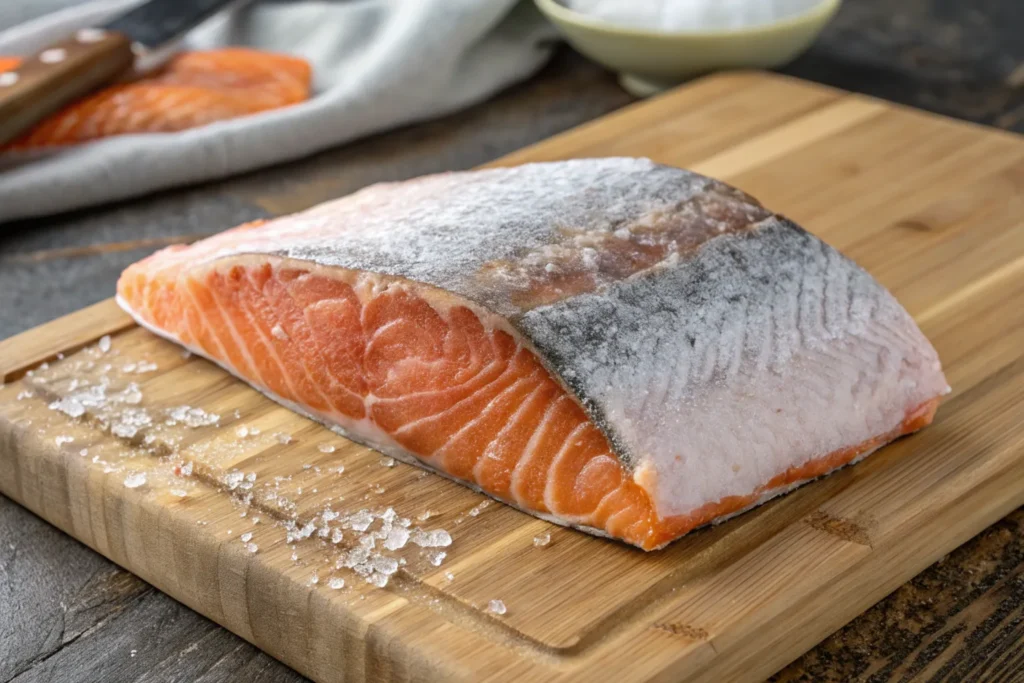
1. Optimal Freezing Duration
Salmon stays at peak quality in the freezer for up to 3 months. After this period, it’s still safe to eat but may lose some of its flavor and texture.
2. Extended Freezing with Proper Storage
If you vacuum-seal the salmon or use airtight packaging, it can last up to 6 months without significant changes in taste or texture. This method is especially useful for bulk storage or meal prep.
3. Signs It’s Been Frozen Too Long
If salmon develops large ice crystals, a grayish color, or a dry texture after thawing, it may have been in the freezer too long. Proper wrapping can help prevent these issues and keep your salmon fresh.
For the best taste, use frozen salmon within the first few months. Whether you’re preparing it for recipes like Baked Sweet Chili Salmon or simply grilling it, fresh-tasting salmon makes all the difference.
How to Thaw Frozen Salmon?
Thawing salmon properly is just as important as freezing it correctly. Safe and effective thawing ensures the fish retains its flavor, texture, and quality. Here are the best methods to thaw frozen salmon:
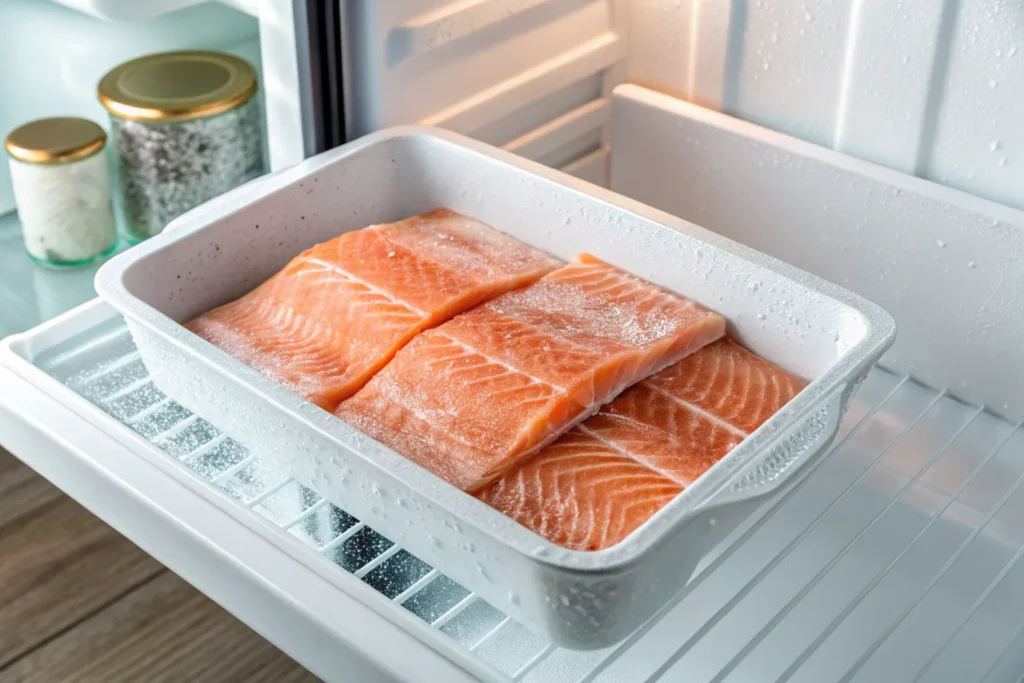
1. Refrigerator Method
The safest way to thaw salmon is in the refrigerator. Place the frozen salmon (still wrapped) on a plate or in a shallow dish to catch any liquids as it thaws. Allow it to defrost overnight or for about 8–12 hours, depending on the thickness of the fillets. This gradual thawing keeps the salmon at a safe temperature and prevents bacteria growth.
2. Cold Water Method
If you need to thaw salmon more quickly, the cold water method works well. Submerge the wrapped salmon in a bowl of cold water, ensuring the packaging is airtight to prevent water from seeping in. Change the water every 30 minutes to keep it cold. Small fillets can thaw in about 1–2 hours using this method.
3. Avoid Room Temperature Thawing
Never thaw salmon at room temperature. This can cause uneven thawing, with the outer layers reaching unsafe temperatures while the inside remains frozen. Room temperature thawing increases the risk of bacteria growth and foodborne illness.
4. Can You Cook Salmon Without Thawing?
Yes! If you’re short on time, you can cook salmon straight from frozen. Adjust the cooking time to allow for even cooking. For example, baked salmon from frozen might take an additional 5–10 minutes. Use seasonings or glazes like those from Pineapple Sweet Chili Salmon to add flavor.
Proper thawing ensures your salmon is ready for your next meal without compromising on taste or safety.
Tips for Freezing and Storing Salmon
To ensure your frozen salmon retains its peak quality and freshness, follow these expert tips for freezing and storing:
1. Freeze Salmon the Same Day You Buy It
If you’re wondering, can you freeze salmon, the answer is yes but timing matters. Freeze salmon as soon as possible after purchasing or catching it to lock in its freshness and flavor.
2. Portion Before Freezing
Divide the salmon into individual portions before freezing. This makes it easier to thaw only what you need for recipes like Baked Sweet Chili Salmon or Healthy Deviled Eggs Without Mayo.
3. Wrap Tightly to Prevent Freezer Burn
Freezer burn occurs when air reaches the salmon, causing dry spots and loss of flavor. Wrap each portion tightly in plastic wrap, followed by a freezer bag or vacuum seal for the best protection.
4. Label and Date Your Packages
Always label the packaging with the freezing date and portion size. This helps you keep track of freshness and use older packages first.
5. Freeze Flat for Space Efficiency
Lay salmon portions flat in the freezer to save space and ensure even freezing. Once frozen solid, you can stack them neatly for better organization.
6. Don’t Refreeze Thawed Salmon
Once thawed, salmon should not be refrozen as this can affect its texture and flavor. Cook and consume it promptly or use leftovers in dishes like Rotisserie Chicken Casserole Stuffing.
7. Use a Vacuum Sealer for Longer Storage
If you plan to freeze salmon for more than a few months, invest in a vacuum sealer. This removes air and extends the storage time to up to 6 months without losing quality.
By following these tips, you’ll keep your frozen salmon tasting fresh and ready for your next culinary creation.
Signs Your Frozen Salmon Has Gone Bad
Even with proper freezing and storage, it’s essential to know when salmon is no longer safe to eat. Here are the key signs that your frozen salmon has spoiled:
1. Discoloration
Fresh salmon should have a vibrant pink or orange color. If your thawed salmon appears grayish, dull, or has dark spots, it’s a sign that the fish is no longer good to eat.
2. Ice Crystals or Freezer Burn
While small ice crystals are normal, excessive or large crystals inside the packaging indicate freezer burn. This can dry out the salmon, leaving it tough and flavorless after cooking.
3. Slimy or Sticky Texture
After thawing, salmon should feel firm and slightly moist. A slimy or sticky texture is a sign of spoilage and means the fish should be discarded.
4. Off-Putting Smell
Fresh salmon has a mild, ocean-like smell. If it emits a sour, rancid, or overly fishy odor after thawing, it’s no longer safe to consume.
5. Unusual Taste
If you cook the salmon and it tastes bitter, sour, or off, it’s a clear indicator that the fish has spoiled even if it looked fine before cooking.
Knowing these signs helps you avoid potential foodborne illnesses and ensures you only enjoy the best quality salmon. For guidance on fresh salmon preparation, check out recipes like Pellet Grill Salmon or Creamy Cucumber Salad.
Can You Freeze Cooked Salmon?
Yes, you can freeze cooked salmon, but it requires extra care to preserve its moisture and texture. Freezing cooked salmon is a great way to avoid waste and save leftovers for future meals. Here’s how to do it right:
1. Cool Completely Before Freezing
Allow the cooked salmon to cool completely at room temperature before freezing. This prevents condensation, which can lead to ice crystals and freezer burn.
2. Wrap Tightly
Wrap the cooked salmon tightly in plastic wrap to lock in moisture. For additional protection, place the wrapped portions in a freezer bag or airtight container. Vacuum sealing is ideal for longer storage.
3. Freeze in Small Portions
Divide the salmon into smaller portions to make thawing and reheating easier. This way, you can defrost just enough for a recipe like Rotisserie Chicken Casserole Stuffing or a light salad.
4. Use Within 2–3 Months
Cooked salmon is best enjoyed within 2–3 months of freezing. After this time, it may lose its flavor and become dry.
5. Reheat Gently
Thaw the cooked salmon in the refrigerator overnight, then reheat it slowly using a microwave, oven, or stovetop. Adding a sauce or glaze, like the one from Baked Sweet Chili Salmon, can help restore moisture.
Freezing cooked salmon is a convenient way to save time and reduce waste, making it perfect for meal prepping or enjoying leftovers without compromising quality.
Can You Freeze Salmon?
Equipment
- plastic wrap
- freezer bags or vacuum sealer
- permanent marker for labeling date and portions
- plate or shallow dish to catch drips during fridge thaw
- bowl for cold-water thaw method
Materials
- fresh salmon fillets
- plastic wrap
- freezer bags or vacuum-sealer bags
- permanent marker (for labeling)
- plate or shallow dish (to thaw on)
- bowl of cold water (for quick-thaw method)
Instructions
- Choose the freshest salmon you can. Look for bright color, firm texture, and no strong fishy odor. Wild-caught often freezes better due to its firmer texture.
- Portion the salmon for future meals. Pat dry to remove excess surface moisture; optionally remove skin and bones (skin can help protect the flesh during freezing).
- Wrap each portion tightly in plastic wrap with minimal air. Place in a freezer bag and press out air, or vacuum-seal for best results. Label with date and portion size.
- Set the freezer to its coldest setting. Lay portions flat in a single layer to freeze quickly and evenly; once solid, stack to save space.
- For safest thawing, keep salmon wrapped and thaw on a plate or shallow dish in the refrigerator for 8–12 hours, depending on thickness.
- For a quicker thaw, submerge the wrapped salmon in a bowl of cold water, changing the water every 30 minutes. Small fillets thaw in about 1–2 hours.
- Do not thaw at room temperature; outer layers can reach unsafe temps while the center remains frozen, increasing food safety risks.
- You can cook salmon from frozen; add 5–10 minutes to bake time and season as desired.
Notes
Conclusion
Freezing salmon is an excellent way to preserve its freshness, reduce waste, and ensure you always have this versatile fish on hand. By following the proper steps like using airtight packaging, freezing quickly, and thawing safely you can maintain the quality and flavor of both raw and cooked salmon for months.
Whether you’re freezing leftovers from a recipe like Rotisserie Chicken Casserole Stuffing or preparing fresh fillets for future use, these techniques will help you make the most of your salmon. Remember to label and portion your salmon for convenience and use it within the recommended time frame for the best results.
With the right approach, frozen salmon can taste just as delicious as fresh, giving you endless options for quick, healthy meals. So, next time you’re wondering, can you freeze salmon, the answer is a resounding yes just do it right!
LET’S STAY CONNECTED! FOLLOW ME ON:
Tried this recipe? I’d be thrilled to see your take on it! Snap a pic and tag me @Sweftyrecipes so I can share your delicious creations with our foodie community.
→ FACEBOOK | INSTAGRAM | PINTEREST
FAQs: Can You Freeze Salmon?
1. Can I freeze uncooked salmon?
Yes, you can freeze uncooked salmon! It’s one of the best ways to preserve its freshness and quality for longer storage. For best results, freeze it as soon as possible after purchasing or catching. Use vacuum-sealed packaging or wrap the salmon tightly in plastic wrap followed by a freezer bag.
2. Why is salmon not suitable for freezing?
Salmon is suitable for freezing, but improper techniques can make it less appealing. Freezer burn, caused by air exposure, can dry out the salmon, leading to a tough texture and loss of flavor. Proper wrapping and quick freezing are essential to maintain its quality.
3. Does salmon still taste good after freezing?
Yes, salmon can taste just as good after freezing if stored properly. The key is to freeze it quickly, use airtight packaging, and consume it within 3–6 months. Recipes like Baked Sweet Chili Salmon work wonderfully with frozen salmon.
4. Can you freeze salmon in a Ziploc bag?
You can freeze salmon in a Ziploc bag, but make sure to remove as much air as possible to prevent freezer burn. For better results, consider double-wrapping the salmon with plastic wrap before placing it in the Ziploc bag.
5. Can raw salmon last 4 days in the fridge?
No, raw salmon should only be stored in the refrigerator for 1–2 days. If you’re not planning to cook it within that time frame, freezing is the best option to extend its shelf life. For safe and flavorful preparation, check out recipes like Pellet Grill Salmon.

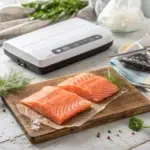
Comments are closed.